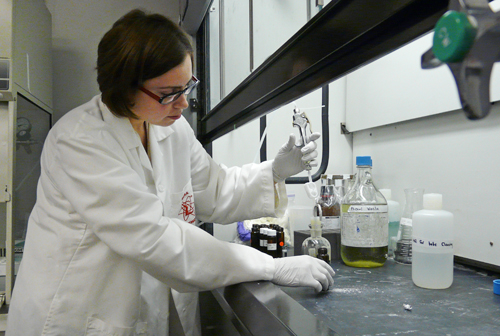A New Way to Track the Presence of Toxic Oil Contaminants in Sensitive Ecosystems
Research by Leslie Slasor at Oregon Health Sciences University
Hydrocarbon pollution has been, and will continue to be, a problem in marine environments. Extraction, transportation and consumption of petroleum products[1] are the main forms of hydrocarbon pollution. The recent tragedy of the 2010 Deepwater Horizon oil spill emphasized a need for better, more precise instrumentation designed to track crude oil plumes in the water column (from surface to sea floor). Where previous oil spills were relatively easy to locate and sample (Exxon Valdez and Prestige oil spills, for example) occurring on or near surface waters and beaches, the Gulf spill was the first to occur at depths of over 3,000 feet. The underwater oil plumes that formed created unique problems that require unique solutions. OHSU,[2] WETLabs,[3] and USF[4] came together in a collaborative effort to improve in situ[5] instrumentation detection and tracking of certain toxic components of crude oil[6]: Polycyclic Aromatic Hydrocarbons (PAHs)[7]. Understanding the fate of a pollutant like crude oil (where it ends up, how it gets there and how it breaks down) will help improve our response and clean-up efforts as well as predict future impacts to our complex and delicate marine ecosystems.
In situ fluorometers were used to detect crude oil plumes[8] in the Gulf of Mexico after the Deepwater Horizon oil spill. However, there is potential to increase the specificity of these instruments enabling scientists to track potentially harmful components of crude oil. PAHs are toxic, several being listed on the Environmental Protection Agency’s (EPAs) List of Priority Pollutants.[9] They are also fluorophores (molecules that fluoresce). This means they are able to absorb light energy and then re-emit that light energy at wavelengths specific to the compound or group of compounds, giving each a unique signature or fingerprint. The fluorescent properties of PAHs make fluorescence spectroscopy an ideal form of detection. Our lab at OHSU uses a benchtop spectrofluorometer to detect the fingerprints of PAHs that have dissolved or naturally dispersed (not using any special chemicals) in artificial seawater. The resulting fingerprints represent the unique composition and relative concentration of PAHs in the oil samples.
Crude oil undergoes a multifaceted weathering process in the natural environment, including evaporation, dissolution/dispersion, photodegradation and biodegradation. Our study focuses on the dissolved/dispersed portion of crude oil in seawater, and the effects of photo- and biodegradation on fluorescent properties of PAHs. Determining relative degradation rates will give us a better understanding of the persistence of these toxins. This study will also aid in identifying fluorescence signatures specific to PAHs for in situ instrumentation to selectively target. Fluorometers that can track long-range transport of persistent crude oil contaminants in the water column will be a key addition to the tools that scientists use for oil spill response and recovery.
PAH pollution could have serious negative impacts on food sources, including fish and other seafood.[10],[11] Advancements in instrumentation will create more effective, less expensive ways to identify and track these hazardous contaminants. This study is aiding in the improvement of in situ instrument development, allowing for more precise and accurate detection and tracking of subsurface hydrocarbon pollution in marine environments. These improvements can and will be applied in the Gulf as well as other aquatic environments affected by crude oil and/or PAHs, aiding us in determining the potential impact of PAH contamination and its effect on human health. Our complex and fragile oceans need to be monitored in order to truly assess our impact and bolster our response efforts.
Leslie Slasor received her B.S. in Chemistry from Eastern Kentucky University, where she studied Forensic Chemistry and contributed to Organic Chemistry and Computational Biochemistry research. She is currently working on a M.S. in Environmental Science and Engineering at Oregon Health and Sciences University, and her masters thesis research involves the spectral fluorescence study of crude oil in seawater. Her research interests include human influence on water quality, contaminant transport and remediation in aquatic systems.
[2] http://www.stccmop.org/news/multimedia/images/oil_and_water_mix
[3] http://www.wetlabs.com
[4] http://www.marine.usf.edu/faculty/paula-coble.shtml
[5] In situ literally means “in position.” In this case we are using the term in situ to indicate that these instruments can be placed directly in the ocean (or other aquatic environments) as opposed to those used in a laboratory with samples of seawater.
[6] http://science.howstuffworks.com/environmental/energy/oil-refining1.htm
[7] http://www.epa.gov/ttnatw01/hlthef/polycycl.html
[8] http://www.wetlabs.com/cdomincrude.htm
[10] http://www.epa.gov/R5Super/ecology/html/toxprofiles.htm
[11] http://www.fda.gov/food/ucm210970.htm
























NO COMMENT
Leave a comment